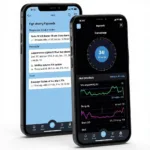If you’re wondering whether your automatic car is compatible with an OBD2 scanner, the answer is a resounding yes! OBD2, short for On-Board Diagnostics, is a standardized system implemented on all gasoline vehicles sold in the United States since 1996, and diesel vehicles since 2001, regardless of their transmission type.
What Does OBD2 Do in Automatic Cars?
Just like in their manual counterparts, the OBD2 system in automatic cars acts as a diagnostic window into your vehicle’s engine and transmission control units. It allows you to:
- Read and clear trouble codes (DTCs): These codes are triggered when your car’s onboard computer detects an issue. With an OBD2 scanner, you can identify these codes and understand what they mean, giving you a starting point for diagnosis and repair.
- Monitor live data: OBD2 scanners can display real-time information from various sensors, including engine RPM, coolant temperature, oxygen sensor readings, and even transmission fluid temperature in automatic cars. This data is invaluable for troubleshooting problems, monitoring performance, and even optimizing fuel efficiency.
 OBD2 Scanner Displaying Automatic Transmission Data
OBD2 Scanner Displaying Automatic Transmission Data
Automatic Transmission-Specific Data with OBD2
While OBD2 provides a standardized way to access vehicle data, the specific parameters available for automatic transmissions can vary depending on the car make, model, and the scanner’s capabilities. However, some common data points related to automatic transmissions you might find include:
- Gear position: This tells you which gear the transmission is currently engaged in (e.g., Park, Reverse, Drive, Neutral).
- Transmission fluid temperature: Monitoring this is crucial for automatic transmission health, as overheating can lead to significant damage.
- Torque converter lockup: This information helps determine if the torque converter is engaging and disengaging properly, which impacts fuel efficiency and acceleration.
- Shift solenoids: These solenoids control the flow of transmission fluid to engage different gears. Monitoring their status can help diagnose shifting problems.
Choosing the Right OBD2 Scanner for Your Automatic Car
Selecting the right OBD2 scanner depends on your needs and budget. Here’s a quick breakdown:
- Basic code readers: These are the most affordable option and are primarily designed to read and clear trouble codes. They are sufficient for basic diagnostics and DIY repairs.
- Advanced scan tools: These offer more features, including live data monitoring, graphing capabilities, and even the ability to perform some diagnostic tests. They are ideal for more in-depth diagnostics and troubleshooting.
- Professional-grade scanners: These are the most expensive and feature-rich options typically used by mechanics and professional technicians. They offer comprehensive diagnostic capabilities, including bi-directional communication with the vehicle’s systems.
Pro Tip from John Miller, ASE Certified Master Technician: “Even if you’re not a car expert, a basic OBD2 scanner can empower you to understand your automatic car better and potentially save on unnecessary mechanic visits.”
Beyond Diagnostics: OBD2’s Potential
OBD2’s capabilities extend far beyond basic diagnostics. When combined with smartphone apps or dedicated software on your computer, you can unlock a world of possibilities:
- Performance monitoring: Track your car’s acceleration, braking, and other performance metrics in real-time.
- Fuel economy tracking: Monitor your fuel consumption habits and identify areas for improvement.
- Trip logging and analysis: Log your trips, track mileage, and even analyze driving behavior for business or personal use.
Conclusion
Whether you drive an automatic or manual, OBD2 is an essential tool for any car owner. It provides a standardized way to interact with your vehicle’s computer, empowering you with valuable information about its health and performance. By understanding how to use an OBD2 scanner effectively, you can become a more informed car owner, troubleshoot issues, and potentially save on costly repairs. Remember to choose an OBD2 scanner that suits your needs and explore the vast world of apps and software that can further enhance your diagnostic experience.

